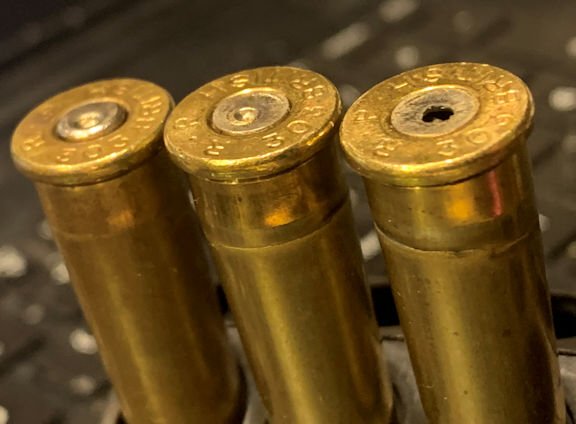Most of you know I’ve been getting my feet wet, and slowly (cautiously) been getting into reloading. I’ve made up several ‘by the book safe zone’ loads of different calibers, in the last 6 months or so, but have yet to shoot any. I’ll be going to the range soon to test my 6.5 CM rounds. Over the process of learning, I’ve both read and seen in videos where they mention to “watch for signs of over pressuring”. I’ve seen and read many things on what to look for with primers, but could someone describe other signs to look for?
You are using an out of date browser. It may not display this or other websites correctly.
You should upgrade or use an alternative browser.
You should upgrade or use an alternative browser.
This site may earn a commission from merchant affiliate
links, including eBay, Amazon, and others.
Difficult extraction or ejection of fired cartridge, easier to tell with a manual extraction like a bolt action or revolver. Split cases, especially if you know they haven't been reloaded multiple times. Excessive recoil (many recommend firing some factory rounds to establish a baseline of "normal" recoil). And as you mentioned, primer condition....
Pressure looks something like these.

The first one on the left shows a touch of what appears to be excess headspace in the backed out primer. Primer isn't flattened.
Middle has flattened primer partial head separation. This is definitely a sign of over pressure.
The one on the right fully flattened primer, pierced primer and almost full head separation. Classic pressure signs.
Go back and look at the first case again, it shows the ring from head separation starting also. This is an over pressure sign.
The backed out primer is misleading as this design gun has generous headspace. Maximum go gauge is .010 and backed out primers is a characteristic.
These three cartridges .303 British were fire one after another in a Martini hinge block single shot rifle made around 1889-1890. The gun is marked. "ammunition: .303" The groove diameter of this gun is .303. The .303 British cartridge uses a .311 diameter bullet. Overpressure from firing an oversized .311 bullet in .303 groove barrel.
When the British first developed the .303 British cartridge the experimente with .303, .307 and .311 groove barrels. When finally introduced in 1892/93 they settled on a .311 groove.

The first one on the left shows a touch of what appears to be excess headspace in the backed out primer. Primer isn't flattened.
Middle has flattened primer partial head separation. This is definitely a sign of over pressure.
The one on the right fully flattened primer, pierced primer and almost full head separation. Classic pressure signs.
Go back and look at the first case again, it shows the ring from head separation starting also. This is an over pressure sign.
The backed out primer is misleading as this design gun has generous headspace. Maximum go gauge is .010 and backed out primers is a characteristic.
These three cartridges .303 British were fire one after another in a Martini hinge block single shot rifle made around 1889-1890. The gun is marked. "ammunition: .303" The groove diameter of this gun is .303. The .303 British cartridge uses a .311 diameter bullet. Overpressure from firing an oversized .311 bullet in .303 groove barrel.
When the British first developed the .303 British cartridge the experimente with .303, .307 and .311 groove barrels. When finally introduced in 1892/93 they settled on a .311 groove.
Read all of this it is very very informative. He has 6.5 loads at the bottom that show different pressure signs.
I think all handloaders need to read and understand this.
Most of us that have been doing it for years know it.
https://www.primalrights.com/library/articles/understanding-pressure
I think all handloaders need to read and understand this.
Most of us that have been doing it for years know it.
https://www.primalrights.com/library/articles/understanding-pressure
Pressure problems can come from too little powder also.
Most reloading manuals have discussions about over pressure with good pictures.
Primer extrusion and pierced primers can also be caused by mechanical issues.
Primer extrusion and pierced primers can also be caused by mechanical issues.
If you follow the reloading manuals and use their powder charges and COL, it's near impossible to ever encounter pressure signs. They're safe to cover their butt. Once you start experimenting and pushing things with powder charges and seating depths, then it's wise to know what to look for. Pistol cartridges even more so imo.
Very good article here: https://www.primalrights.com/library/articles/understanding-pressure
Very good article here: https://www.primalrights.com/library/articles/understanding-pressure
That is what I posted in post #4
Good read for sure. Thanks SwampRead all of this it is very very informative. He has 6.5 loads at the bottom that show different pressure signs.
I think all handloaders need to read and understand this.
Most of us that have been doing it for years know it.
https://www.primalrights.com/library/articles/understanding-pressure
Similar threads
- Replies
- 23
- Views
- 763
- Replies
- 46
- Views
- 3K
- Replies
- 28
- Views
- 2K
Latest posts
-
-
-
looks like easy pawn in claremore is auctioning everything off
- Latest: Shoot Summ
-
-
-
-
-
-
-
-
-
-
-
-
-
-
-
Join the conversation!
Join today and get all the highlights of this community direct to your inbox. It's FREE!
- Curated content sent daily, so you get what's interesting to you!
- No ads, no large blocks of text, just highlights for easy digest
- It's all totally free!
Enter your email address to join:
Thank you for joining!
Already
a member? Click here to log in














